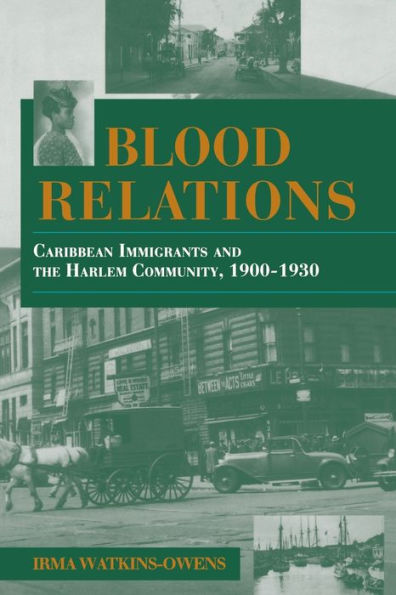Blood Relations: Caribbean Immigrants and the Harlem Community, 1900-1930
In Blood Relations, Irma Watkins-Owens focuses on the complex interaction of African Americans and African Caribbeans in Harlem during the first decades of the 20th century. Between 1900 and 1930, 40,000 Caribbean immigrants settled in New York City and joined with African Americans to create the unique ethnic community of Harlem. Watkins-Owens confronts issues of Caribbean immigrant and black American relations, placing their interaction in the context of community formation. She draws the reader into a cultural milieu that included the radical tradition of stepladder speaking; Marcus Garvey's contentious leadership; the underground numbers operations of Caribbean immigrant entrepreneurs; and the literary renaissance and emergence of black journalists.Through interviews, census data, and biography, Watkins-Owens shows how immigrants and southern African American migrants settled together in railroad flats and brownstones, worked primarily at service occupations, often lodged with relatives or home people, and strove to "make it" in New York.
1132868816
Blood Relations: Caribbean Immigrants and the Harlem Community, 1900-1930
In Blood Relations, Irma Watkins-Owens focuses on the complex interaction of African Americans and African Caribbeans in Harlem during the first decades of the 20th century. Between 1900 and 1930, 40,000 Caribbean immigrants settled in New York City and joined with African Americans to create the unique ethnic community of Harlem. Watkins-Owens confronts issues of Caribbean immigrant and black American relations, placing their interaction in the context of community formation. She draws the reader into a cultural milieu that included the radical tradition of stepladder speaking; Marcus Garvey's contentious leadership; the underground numbers operations of Caribbean immigrant entrepreneurs; and the literary renaissance and emergence of black journalists.Through interviews, census data, and biography, Watkins-Owens shows how immigrants and southern African American migrants settled together in railroad flats and brownstones, worked primarily at service occupations, often lodged with relatives or home people, and strove to "make it" in New York.
24.0
Out Of Stock
5
1

Blood Relations: Caribbean Immigrants and the Harlem Community, 1900-1930
256
Blood Relations: Caribbean Immigrants and the Harlem Community, 1900-1930
256
24.0
Out Of Stock

Product Details
| ISBN-13: | 9780253210487 |
|---|---|
| Publisher: | Indiana University Press |
| Publication date: | 03/22/1996 |
| Series: | Blacks in the Diaspora |
| Edition description: | New Edition |
| Pages: | 256 |
| Product dimensions: | 6.12(w) x 9.25(h) x (d) |
| Age Range: | 18 Years |
About the Author
From the B&N Reads Blog
